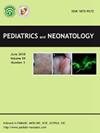对极早产儿严重支气管肺发育不良临床变量的综合分析。
IF 2.1
4区 医学
Q2 PEDIATRICS
引用次数: 0
摘要
背景:识别可能预测极早产儿和极早产儿严重支气管肺发育不良(BPD)发展的临床危险因素,有助于临床医生实施早期干预,以降低长期发病率和死亡率。方法:对2018年5月至2022年1月期间入组的32周前出生的早产儿进行队列研究。从医疗记录中回顾性收集临床参数和合并症,并根据2019年美国国家儿童健康与人类发展研究所标准的诊断定义,比较不同BPD严重程度。随机森林模型用于对严重BPD发展的临床变量的重要性进行独立排序。结果:共有134名早产儿被纳入研究,然后根据他们的BPD严重程度分为三组。与无BPD或轻度BPD的婴儿不同,重度BPD早产儿的GA、出生体重和5分钟时Apgar评分明显较低(P)。结论:低出生体重、败血症和PDA的存在都在极早产儿重度BPD的发展中起重要作用。本文章由计算机程序翻译,如有差异,请以英文原文为准。
A comprehensive analysis of clinical variables for severe bronchopulmonary dysplasia in extremely preterm infants
Background
Identifying clinical risk factors that may forecast the development of severe bronchopulmonary dysplasia (BPD) in very and extremely premature infants can assist clinicians in implementing early interventions to reduce long-term morbidity and mortality rates.
Methods
A cohort study of enrolled preterm neonates born before the gestational age (GA) of 32 weeks was performed between May 2018 and January 2022. Clinical parameters and comorbidities were gathered retrospectively from medical records and compared among different BPD severity levels based on the diagnostic definition of the 2019 National Institute of Child Health and Human Development criteria. Random forest models were used to rank the importance of clinical variables independently for severe BPD development.
Results
A total of 134 preterm infants were enrolled and then divided into three groups based on their BPD severity. Unlike infants with no or mild BPD, the GA, birth weight, and Apgar score at 5 min were considerably lower in preterm infants with severe BPD (P < 0.001). Subgroup analysis of preterm infants born before GA 28 weeks revealed that only birth weight was significantly lower in those with severe BPD (P = 0.001). Furthermore, sepsis rates were significantly higher in extremely preterm infants with severe BPD (P < 0.001). Using random forest analysis, sepsis, birth weight, and patent ductus arteriosus (PDA) appeared to have the highest importance for severe BPD in extremely premature infants.
Conclusion
Lower birth weight, sepsis, and the presence of PDA all play important roles in the development of severe BPD in extremely preterm infants.
求助全文
通过发布文献求助,成功后即可免费获取论文全文。
去求助
来源期刊

Pediatrics and Neonatology
PEDIATRICS-
CiteScore
3.10
自引率
0.00%
发文量
170
审稿时长
48 days
期刊介绍:
Pediatrics and Neonatology is the official peer-reviewed publication of the Taiwan Pediatric Association and The Society of Neonatology ROC, and is indexed in EMBASE and SCOPUS. Articles on clinical and laboratory research in pediatrics and related fields are eligible for consideration.
 求助内容:
求助内容: 应助结果提醒方式:
应助结果提醒方式:


